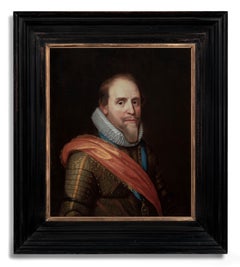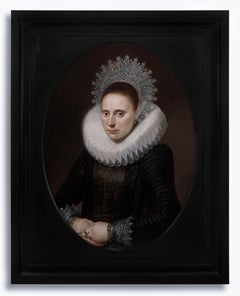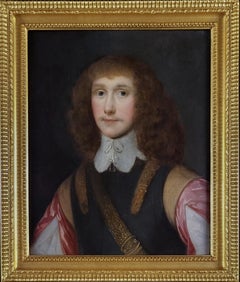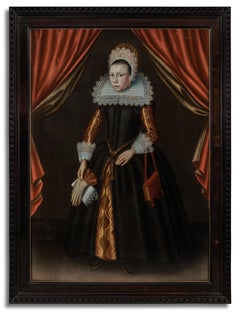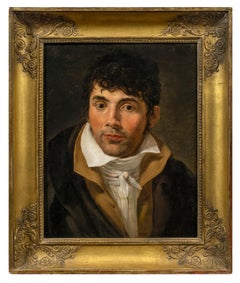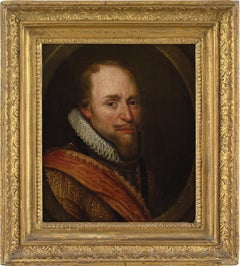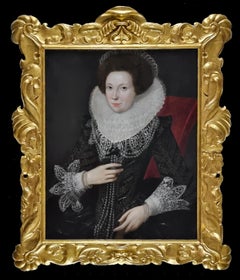Panel More Art
to
6
6
2
2
2
Overall Height
to
Overall Width
to
40
36
30
25
6
5
4
3
2
1
1
1
1
1
6
42
42
32
31
6
Style: Old Masters
Medium: Panel
Dutch Old Master Portrait of Maurits, Prince of Orange-Nassau, Oil on Panel
Located in London, GB
In 1607, the Delft city council decided to commission a portrait of Stadholder Maurits of Nassau for the town hall, with Michiel van Mierevelt as the chosen artist due to the passing...
Category
17th Century Old Masters Panel More Art
Materials
Oil, Wood Panel
Portrait of a Lady in an Elaborate Ruff & Lace Coif c.1610-20, Dutch Old Master
Located in London, GB
This magnificent oil on panel portrait, presented by Titan Fine Art, is a splendid example of the sumptuous female portraits that were painted for members of the upper echelons of so...
Category
17th Century Old Masters Panel More Art
Materials
Oil, Wood Panel
Portrait of Gentleman, Thomas Bruce, Earl of Elgin c.1638 Manor House Provenance
Located in London, GB
Titan Fine Art present this picture which formed part of a historic collection of an English aristocratic family, Lord and Lady Sandys at their magnificent baroque and Regency Grade-...
Category
17th Century Old Masters Panel More Art
Materials
Oil, Wood Panel
Portrait of a Lady Diana Cecil, Countess of Elgin c.1638, Manor House Provenance
Located in London, GB
Titan Fine Art present this picture which formed part of a historic collection of an English aristocratic family, Lord and Lady Sandys at their magnificent baroque and Regency Grade-...
Category
17th Century Old Masters Panel More Art
Materials
Oil, Wood Panel
Portrait Gentleman Black Slashed Doublet & Orange Sash Dutch Oil on Panel c.1650
By Bartholomeus van der Helst
Located in London, GB
This exquisite portrait of a gentleman depicted in a sumptuous black doublet edged with silver and slashed sleeves is an excellent example of the type of portrait fashionable in England and the Low Countries during the 17th century. The confident pose, striking orange sash - the colour of the house of Orange Nassau - and the leather gorget imbue the sitter with a sense of masculinity and power. The profusely decorated costume is of the highest quality and de rigueur of an elite class - the artist has carefully cultivated this portrait to emphasise the sitter’s wealth and standing in the society that he belonged to. The casual pose, with one arm resting on a hip, is much less formal than earlier decades, and it speaks of ‘sprezzatura’ – one’s appearance should not appear laborious, but instead, effortless.
The oil on cradled panel portrait can be dated to circa 1650 based on the hairstyle and the attire - small falling collar, short doublet (doublets reduced in size to just below the ribcage in the late 1650’s), and the type of slashed sleeves with the sleeve seams left open to reveal the white fabric.
The demand for portraits in the Netherlands was great in the 17th century. Bartholemeus van der Helst was considered to be one of the leading portrait painters of the Dutch Golden Age surpassing even Rembrandt as the most sought-after portraitist in Harlaam. The Dutch Golden Age, roughly spanning the 17th century, was a period when Dutch trade, science, military, and art were among the most acclaimed in the world. Dutch explorers charted new territory and settled abroad. Trade by the Dutch East-India Company thrived, and war heroes from the naval battles were decorated and became national heroes. During this time, The Dutch Old Masters began to prevail in the art world, creating a depth of realistic portraits of people and life in the area that has hardly been surpassed. The Golden Age painters depicted the scenes that their discerning new middle-class patrons wanted to see. This new wealth from merchant activities and exploration combined with a lack of church patronage, shifted art subjects away from biblical genres. Still life’s of items of everyday objects, landscapes, and seascapes reflecting the naval and trade power that the Republic enjoyed were popular. The new wealthy class were keen to have their portraits commissioned and many artists worked in this lucrative field. Such was the popularity of art that everyone had a painting, even the humble butcher, and hundreds of thousands of paintings were produced.
By tradition the sitter is Maarten Tromp (1598-1653) who was an Admiral in the Dutch Navy (the reverse of the portrait contains an old handwritten inscription “van Tromp”). Certainly, the distinctive orange sash is similar to those worn by officers of the Dutch army in the Netherlands who served under the Princes of Orange and the House of Nassau. However, it should be noted that the physiognomy differs from other images of Tromp.
Tromp was the oldest son of Harpert Maertensz, a naval officer and captain. He joined the Dutch navy as a lieutenant in July 1622 and was later promoted from captain to Lieutenant-Admiral of Holland and West Frisia in 1637. In 1639, during the Dutch struggle for independence from Spain, Tromp defeated a large Spanish fleet bound for Flanders at the Battle of the Downs, which marked an enormous change - the end of Spanish naval power. He was killed in action during the First Anglo-Dutch War in 1653 where he commanded the Dutch fleet in the battle of Scheveningen.
Gloves were an absolutely vital accessory and the elaborate pair in this portrait are embellished with threads of silk and precious metals and salmon-coloured lining. He wears only one glove and holds the other, providing an opportunity to better display the cuffs and detail on his right wrist and forearm. The gloves are probably made from the most prized leather which came from Spain, in particular from Cordova. Cordovan leather was tanned with a special vegetal process that left it both highly impermeable and divinely soft. King Charles I, posed in a rather relaxed manner for Daniel Mytens’s portrait in 1631, is wearing gloves and boots in matching Cordovan leather. The hide is thick, but you can see just how supple it is from the way the gauntlet dimples and the long boot legs fold over themselves, rippling and wrinkling at the ankles.
Apart from keeping hands warm the use of gloves during the 15th through the 19th centuries were full of symbolism and they were worn regardless of the season. They kept the skin unblemished - soft, smooth hands were considered highly attractive. This combination of necessity and proximity to bare skin made gloves a deeply personal gift and they took on a strong symbolic significance and were regarded as emblematic of fidelity and loyalty for hundreds of years. Such was the importance of their symbolism was that some gloves were never intended to be worn at all. Their luxury made them ideal gifts at court, and so in the 15th and 16th centuries, ambassadors often presented them as symbols of loyalty.
Until the mid-19th century, it was customary to give gloves as tokens to guests at weddings and to mourners at funerals. Gentleman often gifted their bride-to-be with a pair of gloves (the obligatory gift) and were handed over at the betrothal and put on display before the wedding took place. It was probably their direct contact with the skin that led to the eroticism of gloves. Not only were pairs often exchanged between lovers, but from the 16th to the 18th centuries, it was common practice to remove one glove and give it as a gift to a favourite. The idea of the item being presented still warm from the wearer’s hand is certainly suggestive. Following the death of King George IV, his executors purportedly found over a thousand mismatched ladies’ gloves among his possessions.
The sentiment of a 17th-century poem reveals the popularity of the practice: “Come to our wedding to requite your loves / Shew us your hands and we’ll fit you with gloves.” Such generosity might be pricey for the hosts, but gloves of varying quality could be offered depending on the status of the recipient. Pairs made with the finest Spanish leather might be reserved for immediate family, while coarse sheep’s leather could be distributed among the servants and tradesmen. The apportioning of quality according to class provided a very clear message of the gloves’ intended use. For refined guests, they were decoration; for the lower classes, they were functional.
Bartholomeus van der Helst...
Category
17th Century Old Masters Panel More Art
Materials
Wood Panel, Oil
Dutch Old Master Portrait of Girl aged 9 in Black Dress & Lace Ruff dated 1619
Located in London, GB
Portrait of a Noble Young Girl, aged 9, in a black dress with lace ruff and cuffs, Dated 1619
Circle of Cornelis van der Voort (1576- 1624)
Oil on cradled panel
Presented by Titan ...
Category
17th Century Old Masters Panel More Art
Materials
Oil, Wood Panel
Related Items
Portrait of a Gentleman
Located in New York, NY
Circle of Jacques-Louis David
(French, 18th Century)
Provenance:
Private Collection, Buenos Aires
Exhibited:
“Art of Collecting,” Flint Institute of Art, Flint, Michigan, 23 November 2018 – 6 January 2019.
This vibrant portrait of young man was traditionally considered a work by Jacques-Louis David, whose style it recalls, but to whom it cannot be convincingly attributed. Rather, it would appear to be by a painter in his immediate following—an artist likely working in France in the first decade of the nineteenth century. Several names have been proposed as the portrait’s author: François Gérard, Louis Hersent, Anne-Louis Girodet (Fig. 1), Theodore Gericault, and Jean-Baptiste Wicar, among others. Some have thought the artist Italian, and have proposed Andrea Appiani, Gaspare Landi...
Category
18th Century Old Masters Panel More Art
Materials
Canvas, Oil
Michiel Jansz. Van Mierevelt (Follower), Portrait of Maurice of Orange
Located in Cheltenham, GB
This early to mid-17th-century oil on panel depicts Maurice of Nassau (1567-1625), Prince of Orange. It’s a bust-length portrait, presented in a feigned oval, after a full length by ...
Category
Mid-17th Century Old Masters Panel More Art
Materials
Oil, Wood Panel
Oil Portrait of a Victorian Lady, c. 1850
Located in Chicago, IL
Painted in the 19th century, this exquisite miniature portrait wonderfully exemplifies realism in traditional oil painting. The small artwork is painted in the conventional portraiture style of the Old Masters, and achieves soft realism with fine brushwork and a subdued, neutral palette. The half length portrait depicts a fine Victorian woman dressed in all black with a delicate lace collar and bonnet. She wears a ruby broach...
Category
Mid-19th Century Old Masters Panel More Art
Materials
Oil
Angelic Cherubs with Classical Figure in Wilderness Finely Painted Preparatory
Located in Cirencester, Gloucestershire
Figure with Cherubim in Wilderness
Italian School, 17th century
oil painting on wood panel
framed 13 x 11 inches
condition: overall for its age very good, though the work is most likely a preparatory...
Category
17th Century Old Masters Panel More Art
Materials
Oil, Wood Panel
17th C, Baroque, Saint, Probably Flemish School, Saint Francis in Ecstasy
Located in brussel, BE
During the Counter-Reformation, the traditional cult of saints was encouraged, and spiritual exercises were recommended to come closer to God. In the pai...
Category
17th Century Baroque Panel More Art
Materials
Oil
H 37.8 in W 49.02 in D 2.37 in
Charles Jervas, Portrait of Joseph Mellish
Located in London, GB
Charles Jervas (1675-1739)
Portrait of Joseph Mellish (1675-1733)
Oil on canvas; held in a carved period frame
Dimensions refer to size of frame.
Provenance: Blyth Hall, Nottinghamshire, England; by descent to Sir Andrew Buchanan of Hodsock Priory, Nottinghamshire
In 1635 John Mellish, a merchant tailor of London, bought the estate of Blyth in Nottinghamshire. His son, a wealthy Oporto merchant, dying unmarried, left Blyth in 1703 to a cousin, Joseph Mellish, who became one of Newcastle’s earliest and most important political supporters in the county. He went up to Clare College, Cambridge in 1692 and on to the Inner Temple the following year. He married Dorothea Gore, daughter of Sir William Gore...
Category
Early 18th Century Old Masters Panel More Art
Materials
Oil
Portrait of three children - Bernhard Keil (1624-1687)
Located in Gent, BE
“A portrait of three children, one of them holding a basket of grapes, while another plays the flute”
Oil on canvas
Housed in a blackened 17th-century frame.
We'd like to thank dr...
Category
17th Century Old Masters Panel More Art
Materials
Oil, Panel
The Card Players by a Flemish 1600s Artist
Located in Stockholm, SE
Flemish 1600s School
The Card Players
oil on oak panel
panel dimensions 22.5 x 20 cm
frame included
Provenance:
From a Swedish private collection.
Condition:
Flat and stabl...
Category
17th Century Old Masters Panel More Art
Materials
Oak, Oil, Panel
19th century portrait painted in St Petersburg in 1819
Located in London, GB
Signed, inscribed and dated, lower right:
'Geo Dawe RA St Petersburgh 1819', also signed
with initials, lower centre: 'G D RA'; and signed and inscribed verso:
'Geo Dawe RA Pinxit 1819 St Petersburgh';
Also inscribed on the stretcher by Cornelius Varley with varnishing instructions.
Collections:
Private collection, UK, 2010
Literature:
Galina Andreeva Geniuses of War, Weal and Beauty: George Dawe...
Category
19th Century Old Masters Panel More Art
Materials
Canvas, Oil
Attributed to Cornelius de Neve, Portrait of John, Lord Belasyse
Located in London, GB
Attributed to Cornelius de Neve (circa 1612-1678)
Portrait of John, Lord Belasyse (1614-1689)
Oil on canvas; held in a period style carved polished wood frame.
Dimensions refer to framed size.
Cornelius de Neve, was born in Antwerp, possibly training under the Dutchman Mierveldt and settling in London by 1627. It has been suggested he possibly associated with Van Dyck, though his works show a strong debt to painting in England prior to his arrival, particularly John de Critz...
Category
Mid-17th Century Old Masters Panel More Art
Materials
Oil
H 37.25 in W 32.25 in D 2.5 in
Man in Tavern Smoking a Pipe /// Old Masters Dutch David Teniers Portrait Face
Located in Saint Augustine, FL
Artist: Unknown (Circle of David Teniers the Younger, Flemish, 1610-1690)
Title: "Man in Tavern Smoking a Pipe"
*No signature found
Circa: 1690
Medium: Original Oil Painting on Wooden Board
Framing: Framed in an antique gold gesso frame...
Category
1690s Old Masters Panel More Art
Materials
Gold Leaf
Portrait of a Lady by Fountain in Landscape - Dutch Old Master art oil painting
Located in London, GB
This superb Dutch Old Master portrait oil painting is attributed to circle of Nicolaes Maes. Painted circa 1670, the painting is of a lady, sat by a classical fountain with statue an...
Category
1670s Old Masters Panel More Art
Materials
Oil
Previously Available Items
Dutch Old Master Portrait of Girl aged 9 in Black Dress & Lace Ruff dated 1619
Located in London, GB
Portrait of a Noble Young Girl, aged 9, in a black dress with lace ruff and cuffs, Dated 1619
Circle of Cornelis van der Voort (1576- 1624)
Oil on cradled panel
Presented by Titan ...
Category
17th Century Old Masters Panel More Art
Materials
Oil, Wood Panel
H 57.49 in W 42.92 in D 2.76 in
Portrait of a Lady in Elaborate Costume with Ruff & Pearls c.1615; oil on panel
By Robert Peake the Elder
Located in London, GB
This exquisite, and important, stately portrait, presented by Titan Fine Art, is a particularly splendid example of the sumptuous female portraits that were painted for members of the court and gentry during the early part of the 1600’s. Dress was a key component in portraits, and the exuberant attire and extravagance of jewellery in this painting reiterates the incredible wealth of this Jacobean woman. The pearl coronet on her head is in the style typically only worn by a Duchess of the realm, further signifying her elevated status.
The satin dress is decorated with myriad of fine white lace and embroidered with gold on the bodice and sleeves. The colour black, the most expensive colour of fabric to dye and to maintain, is juxtaposed against white. This striking combination was a favourite of Elizabeth I and courtiers in homage to the queen, just a few years earlier. There is an abundance of pearls, worn on both wrists, and as a heavy double rope around her neck and linked by a black rosette at her breast. Beneath her lavishly decorated dress is a petticoat called a wheel farthingale, an undergarment that flattened the abdomen and tilted the dress up at the back. The style was brought from Spain—possibly by Catherine of Aragon...
Category
17th Century Old Masters Panel More Art
Materials
Oil, Wood Panel
H 40.95 in W 35.04 in D 3.15 in
Elizabethan Portrait of Thomas Vavasour in a Black Doublet c.1587, Oil on panel
Located in London, GB
This exquisite portrait, presented by Titan Fine Art, was painted during the last quarter of the 16th century – the Elizabethan era – the golden age in English History when Queen Elizabeth I was on the throne. It is a splendid survival from circa 1587, a time that is sandwiched between two golden ages of English renaissance culture, the reigns of Henry VIII and Charles I. This period produced a style of painting quite unlike that anywhere else in Europe and one that deserves serious assessment.
The motivation for portraiture during this period was not aesthetic, but rather dynastic - a means to record ancestors. For most individuals the idea of a painting as a work of art perhaps never existed; it was primarily an expression of rank and class. There is not a huge milieu of works remaining from this age and it must also be noted that of the two percent of the population that made up the gentry classes, many would have owned no portraits at all.
Just a couple of years after our portrait was painted, from about 1590, English painting developed on another course, driven mainly by the artists Marcus Gheeraerts the Younger and Isaac Oliver; they depicted a new mood that was pervading Elizabethan and Jacobean society, which was that of romantic melancholy. Elizabethan painting came to an end when Henry, Prince of Wales, sought a complete change of style of his father’s court. In 1610 and 1612 he gathered the talent needed to do just that and invited the Dutch painter Miereveldt, who was seen as the perfect proponent for an updated style, to England.
The portrait is emblazoned with the coat of arms of the Vavasour family - great landowners in Yorkshire and Lincolnshire for centuries; their history dates to Norman times. They are featured on the Battle Abbey Roll and their main seat was Hazlewood Castle, near Tadcaster, from the time of the Domesday Book until 1908. The Vavasours are of Anglo-Norman descent and the various branches of the family are said to have descended from William le Vavasour. During the years between the English Reformation up until the Catholic Emancipation, the Vavasours were noted as a recusant family for remaining staunchly Catholic despite being fined numerous times. By showing up at services several times a year and pretending to conform to Anglicanism, they largely escaped persecution and managed to retain their property and wealth.
The sitter is probably Sir Thomas Vavasour (1560-1620) who was a member of Elizabethan Parliaments. Sir Thomas was the oldest son of Henry Vavasour of Copmanthorpe, Yorks. and Margaret Knyvet. He married Mary Dodge and the couple had four sons and two daughters. His sister, Anne, was Gentlewoman of the Bedchamber about 1580. In 1585 he went over to the Netherlands as Captain of Foot from Yorkshire, retaining this command until 1591, distinguishing himself in an attack on a sconce near Arnhem in Oct 1585, and again two years later. His service in the Netherlands also advanced Vavasour at home. He is thought to have been knighted before August 1595.
Following military service, he was a Gentleman Pensioner until the death of Queen Elizabeth at Richmond Palace...
Category
18th Century Old Masters Panel More Art
Materials
Oil, Wood Panel
H 26.78 in W 20.48 in D 1.97 in
Portrait of Heinrich Mühlegg, Monogrammed & dated 1600, Oil on panel, Gentleman
Located in London, GB
Portrait of Heinrich Mühlegg, the younger (c.1575-1654), Monogrammed and dated 1600
By Lorenz Strauch (1554-c.1630)
This magnificent oil on panel portrait, presented by Titan Fine A...
Category
17th Century Old Masters Panel More Art
Materials
Oil, Panel, Wood Panel
H 31.11 in W 25.79 in D 1.58 in
Fine Portrait of Gentleman in Blue Coat & Powdered Wig c.1775, Rare Oil on Panel
Located in London, GB
A superb and rare example of the artist’s work.
Titan Fine Art present this portrait, a fine example of the late 18th century English school, where the sitter is portrayed in a standard gentlemanly manner. Depicted in a blue coat with large gold buttons, white cravat, and a fashionable powdered wig...
Category
18th Century Old Masters Panel More Art
Materials
Oil, Panel, Wood Panel
Henry WaltonFine Portrait of Gentleman in Blue Coat & Powdered Wig c.1775, Rare Oil on Panel, c.1775
H 13 in W 11.03 in D 1.38 in
Panel more art for sale on 1stDibs.
Find a wide variety of authentic Panel more art available on 1stDibs. While artists have worked in this medium across a range of time periods, art made with this material during the 21st Century is especially popular. If you’re looking to add more art created with this material to introduce a provocative pop of color and texture to an otherwise neutral space in your home, the works available on 1stDibs include elements of blue, pink, purple, orange and other colors. There are many well-known artists whose body of work includes ceramic sculptures. Popular artists on 1stDibs associated with pieces like this include Stefan Traloc, Justin Wheatley, Mauro Oliveira, and Carlton Scott Sturgill. Frequently made by artists working in the Contemporary, Abstract, all of these pieces for sale are unique and many will draw the attention of guests in your home. Not every interior allows for large Panel more art, so small editions measuring 0.1 inches across are also available Prices for more art made by famous or emerging artists can differ depending on medium, time period and other attributes. On 1stDibs, the price for these items starts at $1 and tops out at $929,058, while the average work can sell for $1,104.
Recently Viewed
View AllMore Ways To Browse
Twelve Twenty
Chinese Gouache
Large Yellow Mid Century Painting
Two Cardinales
Old Master Drawing Head
Cubist Poster
Hunt Slonem Large Paintings
Japanese Bow
Japanese Fish Painting
Painting Japan Fish
Dior Summer Dress
Union Jack Art
Large Vintage Advertising Signs
Child And Dog
French Comics
Painting Of A Desk
Animal Trade Signs
Portland Glass
